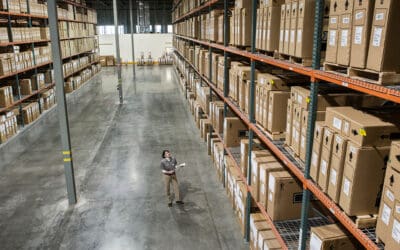MSM serves labs of varying size and type, all with one common thread: optimizing the chain of custody process. Laboratory operations require high-volume throughput with pinpoint accuracy. This is particularly important when you consider a medical lab, for example, where one mistake could mean life or death for the patient.
The Chain of Custody (CoC) Process
Chain of custody is a common procedure that ensures that a specimen, sample or item being produced is properly identified at the start of the process and continues through collection, processing, testing and any other necessary stages until it is delivered. Every step in the process is documented with the date, time, identification of the handler, and other necessary authorizations and information. When this process is manual, documenting CoC requires a lot of paperwork — completed by every individual involved in the process. For most labs we’ve talked to, chain of custody objectives include:
- Maintaining Visibility of the Sample
- Collecting Analytics to Continually Improve Processes
- Optimize Worker Productivity
- Increase Client Service Responsiveness
When a lab is managing hundreds, thousands and even millions of samples with an understanding that knowing the status of every single one is vital to the success of their operations, it becomes a priority to ensure that the process is highly accurate.
In one customer scenario, they received a call from a client regarding the status of a sample that was being processed. The client services team contacted a lab manager who walked through the lab to locate the whereabouts of that sample. Once located, they would determine the status and expected time of completion. Sounds simple enough, but with a large lab with many rooms and stacks of samples it is a very time-consuming process. In fact, this process often requires several personnel who are solely responsible for chasing down the location of samples. Learn more about how we helped this customer solve their chain of custody challenges in our case study.
Other Critical Processes in a Lab Environment
In addition to processing cases, lab facility managers are required to provide proper calibration and maintenance records for all of their testing and lab equipment. This, in and of itself is an ongoing process that can also impact labor costs. Consider the steps:
- Locating each piece of equipment that needs to be managed
- Calculating the utilization metrics for each instrument
- Maintaining records of each specimen tested on the respective devices
- Scheduling and performing regular maintenance
- Maintaining records on each piece of equipment
In addition to maintenance, there’s also management of all the data being collected. Without an automated solution, the paperwork can be overwhelming and require large amounts of storage space. The larger the laboratory, the more time consuming the process, but also the more important it is to properly manage equipment in the facility.
The Four Cornerstones of Operational Efficiency
Identify. Count. Track. Manage.
The most efficient way to improve the CoC process is to implement an automated solution to reduce paperwork and allow resources to be allocated to other areas of the business. Automation minimizes the time spent on each process and reduces bottlenecks. This streamlines workflows and aids in accurately identifying samples, counting cases, tracking the whereabouts of specimens and allows the process to be managed more efficiently. In order to effectively automate the CoC process, both data collection hardware and tracking software like MSM’s PortalTrack are necessary, and can take your lab to the next level without lost productivity and processing delays.
Incorporating the Technology
Barcoding provides an extremely reliable method for tracking and management of items. Use of handheld mobile computers and handheld barcode scanners allows users to simply scan a barcode label on the item at each stage. Information collected throughout the process makes management and reporting paperless, accurate and less time consuming.
RFID is another option that instantly streamlines workflows and ensures integrity of the samples. As cases move through the process, RFID readers capture the flow of each sample, and initiate a login or other prompt for the individual handling the case at each point in the process. Some clients integrate RFID with their existing barcoding process to further provide automated data collection with even greater flexibility. The use of barcodes printed directly on the RFID tags provides the convenience of easily identifying a sample regardless of the method.
In addition to lab operations, RFID can be used in other areas of the business such as inventory and asset management, shipping and records retention.
Once the data is captured through the barcode label or RFID tag, it is pushed out to the PortalTrack system. Used as a standalone solution or integrated with an existing ERP or LIM system, information can be retrieved via the dashboard with complete tracking and history of each sample. This includes dwell times, alerts indicating a sample that has not been processed in the expected amount of time, or provide facility mapping to see exactly what samples are in a certain location. Whether on-premise or cloud-based, PortalTrack updates are made across the board. Another convenient feature of PortalTrack is that it can be integrated with an existing solution without disrupting ongoing workflows. This is most helpful in a healthcare environment where timing is critical.
Streamline Lab Operations with Automated Technology
Explore the options and achieve fast ROI with an automated tracking solution. We make it simple to understand and can show you the difference it can make in your organization. Schedule a free, no-obligation assessment today to get started.


